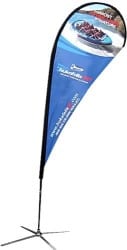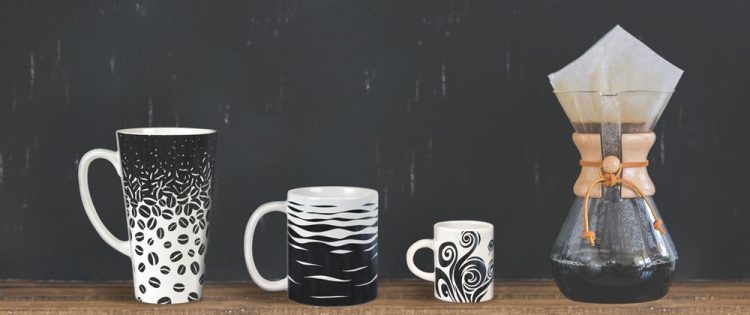Fabric, glass, and rigid substrates for sublimation Printing. And, large versus small format prints.
Question: Can direct-to-textile dye sublimation printed fabric be used for exterior banners or flags?
 You bet. The better dyes now are good for exterior usage, and there are several good options for polyester fabrics that are available for exterior usage.
You bet. The better dyes now are good for exterior usage, and there are several good options for polyester fabrics that are available for exterior usage.
Teardrop flags, beach flags, pop-out banners, and basic banners are all outdoor types of flags and banners that are used every day all over the world to advertise products and services.
Check here to see more details about dye sub printing on outdoor banners and flags.
Question: Can rigid substrates be printed using dye sublimation?
Yes. Many items can be printed using dye sublimation printing such as coffee mugs, snowboards, license plates, and other promotional items.
Treating with Polymer-based Coating
Because the surfaces of these aforementioned items are not polymer-based like polyester fabrics are, the surfaces of these items need to be treated with a special polymer coating to enable these items to accept the sublimation dyes.
Because of the complexity of the surfaces of these and other rigid items, each item will require varying temperatures and pressures and dwell times, as well as being dependent on the variation of heat presses available for these items.
Sublimating the Graphics onto the Substrates
 Once the printed paper has been sublimated to the treated rigid substrate, though, the image has become part of the surface, so no clear-coating or any other surface protection is needed. The image is durable and permanent and won’t wash or rub off. This is why dye sublimation is becoming the choice of many companies that rely on splashy graphics to sell their products.
Once the printed paper has been sublimated to the treated rigid substrate, though, the image has become part of the surface, so no clear-coating or any other surface protection is needed. The image is durable and permanent and won’t wash or rub off. This is why dye sublimation is becoming the choice of many companies that rely on splashy graphics to sell their products.
In the past, you needed to have different types of dye sublimation transfer papers to transfer the dye from the paper to the substrate. However, new innovations in sublimation transfer papers have produced the hybrid transfer paper which is allowing the transfer of images to both rigid and fabric substrates, thus streamlining production as well.
Because the technology of dye sublimation printing is still expanding, it is likely that dye sublimation printing will continue to emerge as one of the favorite forms of printed products, both rigid and fabric. New breakthroughs in the dye sub industry are pointing to the potential for dye sublimation to be used on printed signs and displays where long term usage is required. Literally, the sky is the limit with dye sublimation printing on rigid substrates.
Question: Can dye sublimation printing be used on glass surfaces?
Yes. If the surface is treated with a specialized polymer coating. The way that the polymers work is that when heated and pressed together with the dye sublimation printed transfer paper, the polymers expand, the dye turns to gas, and is infused into the polymers. As the polymers cool, the colorful gases get locked into the polymers, and they become permanently part of the surface of the glass.
Question: How does small format sublimation compare to large format sublimation?
They work the same way, for the most part, but they’re typically used for different products.
Wide format dye sublimation printing is typically used specifically for fabric banners and displays whereas the smaller format heat presses and dye sublimation printing is used for more specialized items like custom mouse pads, glass items, coffee cups, and/or license plates.
However, with the new hybrid transfer papers that have come out, many small items can be printed on the wider papers, the separated to be used on the smaller heat presses if you have more than one unit.
Popular Posts:




